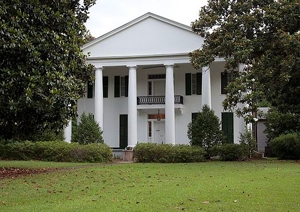Home » Alabama Museums »
1002 Hobson St Greensboro, AL 36744
The Greensboro Alabama Museum is situated on 15 acres in the west end of the town's historic district. It features a Greek Revival-style house that was constructed in 1840 by Colonel Isaac Croom. The property was also the childhood home of Richmond Pearson Hobson, a renowned hero of the Spanish-American War. Visitors can enter the museum upon paying a small admission fee.
Tour the beautiful grounds, View Images, Furniture, View a detached kitchen and slave house.
Tues - Fri 10 a.m. to 4 p.m.
1st Sat of each month 10 a.m. to 2 p.m.
Sun grounds only 1 p.m. to 4 p.m.
Other times by appointment
Magnolia Grove House is a historical house located in Greensboro, Alabama, which is known for its unique architectural style and rich history. This magnificent antebellum mansion was built in 1840 by Isaac Croom, a wealthy plantation owner, and was later owned by several prominent families in the area. The house has been well-preserved over the years and is now open to the public as a museum.
One of the most striking features of Magnolia Grove House is its distinctive Greek Revival architecture. The house is two stories tall, with a central entrance hall flanked by two symmetrical wings. The exterior of the house is made of brick and is adorned with a columned portico, pediments, and a dentil cornice. Inside, visitors can see the original heart pine floors, ornate plasterwork, and period furnishings that are all indicative of the grandeur of the antebellum period.
In addition to its architectural significance, Magnolia Grove House also has a rich history. The house was originally built as a plantation home, and the Croom family owned several hundred slaves who worked on the surrounding farms. During the Civil War, the house served as a Confederate hospital, and later in the 19th century, it became a private school for young ladies. Today, the house is a testament to the social and economic history of the region and provides a glimpse into the lives of the families who lived there.
Visitors to Magnolia Grove House can take a guided tour of the house and grounds. The tour includes a visit to the formal gardens, which were designed in the 1850s and feature a boxwood parterre, a fountain, and a variety of plants and flowers. The gardens are also home to several historic outbuildings, including a kitchen house, a dairy, and a smokehouse.
In addition to the house and gardens, Magnolia Grove House also features a museum store and a visitor center. The museum store sells a variety of souvenirs, including books, postcards, and handmade crafts. The visitor center offers information about the history of the house and the surrounding area, as well as exhibits on topics such as the antebellum period, the Civil War, and the lives of the people who lived and worked on the plantation.
Magnolia Grove House is an important cultural landmark in the state of Alabama and is listed on the National Register of Historic Places. It is also a popular destination for tourists, history buffs, and architecture enthusiasts who want to learn more about the rich history and culture of the region. Whether you are interested in history, architecture, or simply want to enjoy the beauty of the gardens, Magnolia Grove House is a must-see destination.
Overall, Magnolia Grove House is a stunning example of Greek Revival architecture and an important historical landmark in the state of Alabama. The house provides visitors with a unique glimpse into the lives of the families who lived there and the social and economic history of the region. With its beautifully preserved gardens, historic outbuildings, and informative exhibits, Magnolia Grove House is a must-see destination for anyone interested in history, architecture, or Southern culture.
Things to do around Greensboro, Alabama:
- Visit the Greensboro Historic District, which includes several notable buildings and landmarks, such as the Hale County Courthouse, the Greensboro Opera House, and the Greensboro Presbyterian Church.
- Take a tour of the Eutaw Historic District, located about 20 miles from Greensboro. This district features several well-preserved antebellum homes, as well as the Eutaw Methodist Church, which was built in 1836.
- Explore the Moundville Archaeological Site, located about 30 miles from Greensboro. This site features a large complex of prehistoric Native American mounds, as well as a museum that showcases the history and culture of the Mississippian people who inhabited the area from around 1000 to 1450 CE.
- Visit the Freedom Quilting Bee, a cooperative founded in 1966 by a group of African American women who sought to use their quilting skills to earn a living and support their families. Today, the cooperative produces handmade quilts and other crafts, which are sold at their store in nearby Alberta, Alabama.
- Take a scenic drive along the Black Warrior River, which flows through the area and offers beautiful views of the surrounding countryside.
- Go birdwatching at the Black Belt Birding Trail, which includes several sites in the area where visitors can observe a variety of bird species, including migratory birds that pass through the region.
- Attend the Greensboro Catfish Festival, an annual event held in the fall that celebrates the local fishing industry and features live music, food vendors, and a catfish cooking contest.
- Visit the Greensboro Public Library, which houses a collection of rare books and documents related to the history of the area. The library also hosts regular events and programs for visitors of all ages.

